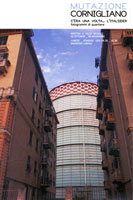Early History and Modern Conflict
The New Organization
The Future
Early History and Modern Conflict
 Cornigliano, originally a splendid seaside resort, was once mentioned by Petrarch. In the 18th and 19th centuries, it became a cultural destination of the Grand Tour with its noble villas and coastal panoramas.
Cornigliano, originally a splendid seaside resort, was once mentioned by Petrarch. In the 18th and 19th centuries, it became a cultural destination of the Grand Tour with its noble villas and coastal panoramas.
In the 20th century, Cornigliano became an important industrial site. Between the 1930s and the 1950s, IRI (Istituto per la Ricostruzione Industriale - an Italian public industrial group), following a plan of Oscar Sinigaglia, created the capital of the “steelworks on the sea”, covering a million square meters.
In the 1980s, under the impetus of local committees and in particular, “Women of Cornigliano”, pressure mounted to close down highly polluting operations, such as blast furnace smelting.
For this reason, since the 1990s, numerous attempts have been made to find a solution to this problem. In the meantime, the public company (Italsider) became private (Ilva-Riva Group).
The New Organization
|
 |
Given the practical impossibility of applying the program agreement of 1999, an accord was finally found in July 2005, and the Modifying Act was signed on the 8th of October 2005.
As a consequence, all hot production ceased completely (the final casting took place on the 29th of July 2005) and areas of about 300,000 square meters were given back to the Public Institutions.
Despite this radical transformation all jobs were entirely safeguarded (about 3,000 direct employees, in addition to those employed in related industries) through an industrial plan that reinforced cold production processes in the area (amounting to about 1,050,000 square meters) conceded to the Riva Group for 60 years. While waiting for the construction of the new plants, stipulated in the industrial plan, (construction is expected to take about three years), 650 workers, who are currently receiving income support, are employed in projects of public utility promoted by the Region of Liguria and managed by the local authorities (community landscaping, maintenance and others).
This is a unique model of a profitable business (Riva Group is one of the main Italian industrial groups and the sixth worldwide steel producer) that has been transformed (and partially closed) for reasons directly connected to an environmental issue.
It is also a rare example of reaching a delicate balance between the undeniable demands of our environment and the legitimate concerns regarding employment.
The Future
|
 |
Now the challenge for the local institutions, which operate through the “Società Per Cornigliano SpA” (Society for Cornigliano) (www.percornigliano.it), is to put these “reconquered” areas (as well as about €215 million in state funding) to carry out a variety of urban renewal projects.
First of all, an environmental reclamation is called for, consisting in the dismantling of old plants, the demolition of obsolete machinery and manufactured objects and, partly, in a land reclamation. This project covers an area of about 256,000 square meters and should last about three years.
Following this preliminary reclamation, the objectives are the following:
1. Various infrastructures
With the construction of a new highway and the relocation of the railway station, this first objective aims to address issues related to traffic in all the Western zone of Genoa and, at the same time, reduce the traffic in Via Cornigliano (currently one of the main sources of air pollution) which will open the door to further urban improvement.
There is a similar project for a new highway parallel to the Genoa-Ventimiglia railway, whose aim is to connect the area of the airport with the area around the Lanterna. Traffic from the Polcevera (a large Genoese Valley) will be connected to

this new road.
2. Area for the port and logistic activities
A second objective is to enlarge the productive spectrum, enabling the port to carry out logistic activities and the handling of merchandise.
Once the reclamation is finished, an area of about 140,000 square meters is expected to be made available to the Harbour Authority, which already has substantial funds at its disposal in order to create new infrastructures for the port

area.
3. Urban Renewal
Finally, but perhaps most importantly, this objective aims to put together the industrial zone with the rest of the city, through a town planning scheme that can respond to the needs of the area. Local authorities are well aware that the new organization of Cornigliano was strongly desired by the citizens and consequently made a reality thanks to their committed engagement. In the same way, any plans for the future development of Cornigliano will not be possible without the direct involvement of the entire community.
For this reason, a Master Plan will be formulated, not only related to the area of the ex-factory, but also concerning all Cornigliano (with particular attention to Via Cornigliano, the bus deposit, Villa Bombrini and Villa Serra) with multiple services linked to the city center as well as to the surrounding area.
The strategy of the Master Plan also plans to promote urban renewal through the creation of a strong magnet; a strategy that has already demonstrated its effectiveness in the area of the Old Port with the Aquarium. Ideally, this magnet would be connected to themes such as science and industry, whose presence has shaped the territory’s past, but whose influence continues to be felt nowadays, and will very likely extend into the future of Cornigliano (Finmeccanica, IIT, Erzelli, etc) along  with the entire Western part of Genoa.
with the entire Western part of Genoa.

